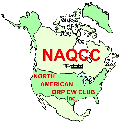
 | NAQCC News |
| Mar 14, 2009 | NAQCC Web Site | Issue #090 | |
|---|---|---|---|
| In this issue: 1. March Sprint. 2. February Challenge Results 3. General Club News 3a. KX1 Project 4. The NAQCC Elmer Project 5. CW Cartoon of the Month 6. News Items and Articles by Our Members |
| 1. SPRINT: Our sprint is this Wednesday evening, March 18 8:30-10:30 PM EDT (Thursday 0030-0230Z). Our special award certificate for this sprint goes to the winner of a drawing among those having the highest score in their division and using an indoor antenna. If you're entering one of our sprints for the first time, we welcome you and hope you will be a regular participant from now on. Last month we welcomed NB4M, KB4WJA, KQ1P, K6APW, VA3NU as first time participants and/or log submitters. Remember this is only a very brief overview of the coming sprint. Be sure to read and understand the full general sprint rules and any specific rules for this month's sprint here. 2. FEBRUARY CHALLENGE RESULTS: This turned out to be one of most popular challenges ever as more and more members are taking to these relaxed month-long events. They are ideal for those who wonder what the club has to offer them since they are not at all interested in sprints or contests. You can work at the challenges any time at all during a month and do it at your own pace. Ideal for the veteran high speed CW op who wants a change of pace as well as the rank newcomer to CW who needs some good on air practice. Also for anyone in between those extremes. They are also a great way to encourage everyone to spend some more time on the air to populate the bands with badly needed CW activity. As a further bonus, a handsome prize is being awarded with some of our challenges thanks to the generous donations of items from our members. This month's prize was a Ladder Grabber donated by Emtech through our club president Tom WY3H. The winner of that in a tie-breaking drawing was Herb K2HPV. However Herb notified us he couldn't use the Ladder Grabber, so we had a second drawing among all the other tied members and this time Bruce WY7N came up the winner. He confirmed he can use it so it is being sent to him. 13 members made all the 15 First Ladies' names in our list. 5 others made at least one name and they plus the other 13 qualified for a Participation point. A certificate is being sent to everyone who made all 15 names. As always, full challenge info and results can be found here. 3. GENERAL CLUB NEWS: - HELP WANTED: The NAQCC is looking for someone to help distribute our club newsletter. A little expertise in doing mass emailings and a couple of free hours a month are the simple requirements. We'll even train you in doing the mass emailings if necessary. Apply to April - N2EI, N4RKR May - VA7JY, KQ1P June - W5YDM, G3REP July - SWL-32 (SM5-1252), N9ND August - G4UUV, K1SHR September - XE1HON, YO4AAC October - N2GJ We now have 132 members' pictures in our picture gallery. Still that is only a small percentage of our total membership of 3,620+, so won't you send us your picture and/or bio for the gallery and/or to be a future featured member if you're one of the ones who hasn't done so yet? It only takes a couple minutes of your time in this busy world of today. Thanks. 3. KX-1 PROJECT - This is the final installment of our series of articles on the KX-1. However we will be mentioning results Mike will be getting with the rig from time to time here in the newsletters. Mike wrote a story describing the whole project from his viewpoint which we will get to in a moment after we tie up a couple loose ends. When we left you last time (remember that common closing line from the old radio serials?), the KX-1 was dead in the water and we ran out of time to figure out why. We thought it had something to do with the tiny little LPF board, but couldn't figure out what at that time. Early in the morning of the day Mike was coming down to finish (hopefully) the project around Noon, I was sitting around waiting to help take my neighbor's dog Joe to the vet, and decided to look at the kit. More or less, the problem jumped right out at me. I noticed a solder pad near where the LPF board was mounted had an empty hole with some remaining traces of solder on it like we had removed a part when adding the LPF board. I decided to check just why it was that way and found out that was where the input to the filter should be. We had removed the old toroids from that area as instructed prior to mounting the LPF board. OK, well where was the input, I wondered. After examining as best I could in the crowded area, I found it in another solder pad. That was obviously the problem. At the end of our previous long day of work, we put the lead in the wrong hole. I waited for Mike to come before attempting to fix it so I could point out to him what we had done, and to give some tips on finding such problems for future reference. Without further ado now, let's get to this from Mike KC2EGL to wrap up the series and to hear how we found one more problem and fixed it also. From Mike KC2EGL: This was my first attempt at building any type of a Amateur Radio Kit. At the start of this project I was very green when it came to using a soldering iron. My only experience with a soldering iron was installing three accessories into my Kenwood TS 480SAT (which resides with John K3WWP at the moment). For starters I thought it would be a tougher project. Elecraft has taken so much of the worry out of building a kit. They have gone above and beyond with the way they lay out the builders manual. Of course there are a few places where you may have to read the instructions more than once just to understand the method behind their madness. If you decide to build a kit from Elecraft please try to remember one thing. DON'T QUESTION THE MANUAL! This was a constant theme between John and myself. We would finish work on one part of the PCB thinking "why do we have to do it like this?". Only to find out a few minutes later that there is no option. Whenever this happened John and I would say in stereo "don't question the manual". We started out assembling two Elecraft 20W dummy load's. One for the KX-1 and one for my K-2. This turned out to be a good exercise for a rookie with a soldering iron. After the dummy load's we did our inventory of parts for each component of our kit. There is the proverbial boatload of parts for this kit. I can only imagine how long a inventory for the K-2 would take. The inventory we did took the whole day. There are plenty of very small parts with very tiny markings. Our kit included the basic KX-1 (20/40M transceiver), Auto antenna tuner, and 30/80M module to make the rig a four band rig. We planned on starting with the smaller components and working our way up to the KX-1. That plan fell apart right from the start. The smallest component was the 30/80M module. After browsing the instructions we found that there would be a few modifications we would have to make to the main PCB on the KX-1 in order to get the 30/80M board to work properly. So we went ahead and assembled the auto antenna tuner. It is very straight forward. The hardest part was winding the toroids. Next time I will order pre-wound toroid's. It was a very good learning experience winding my own toroids. Now that I know what has to be done I will make sure I NEVER have to do it again if at all possible. After the auto antenna tuner was complete we started on the main board. We jumped from one corner to another. From the front side of the board to the back side. And yes sometimes we would look at each other saying "Don't question the manual". Of course we needed a few days of work to complete the main board. We never did count how many items went on the main board. All I know is that there are a lot of parts that must fit on the board. The hardest thing was making sure that we had the proper height for each component. This is a critical step with this kit. If you do not keep all the components at or below the maximum height you will not be able to install the other options properly. After each group of components are installed the manual calls for testing what you have already assembled. All of the testing can be done with a multimeter. They are very straight forward and will tell you what is and what is not working properly. One tool that is a necessity is a insulated tuning tool. I found a package of old insulated tuning tools that are used for CRT TV sets that were in stock at a Radio Shack. We were able to put one of them to use. Unfortunately we needed a tool with a rather small flat tip that would fit in the port hole provided for access to the receiver adjustments. We improvised by using a precision flat tip screwdriver wrapped in electrical tape. This let us adjust each band of the receiver for a peak noise level. The hardest part of this project for us was the assembly of the 30/80M board. There are a few modifications you have make to the main board in order to install the 30/80M board. This is a step that will test your faith in everything. If this were a piece of real estate it would be a very heavily populated neighborhood. The height tolerance with this board is even more precise than any of the other boards. And once you get it installed it is impossible to see if there is anything that may short out the system. After a bit of coaxing we were able to get the board installed on to the main board. First we had to remove two toroids to make room for the 30/80M board. This is where I had a little trouble. I installed one of the toroid leads into the wrong hole on the main PCB. This mistake gave the rig a whopping total of ZERO watts output. I did not find the mistake. John found it. Lucky for us it was a minor fix. It took a bit of time to make the fix but it was minor. The assembly and installation of the 30/80M board was much more difficult than we had anticipated. We thought everything was complete. All of our testing went without a hitch. This included a transmitting test for each band. John would listen for my signal on his rig in his shack while I sent K3WWP DE KC2EGL QRT K through one of the dummy loads. We then headed up to his shack to give it a live test with his antennas. We thought we had finished our project only to find that the rig would not tune properly using the auto antenna tuner. When the rig was completely enclosed the tuning would get us a SWR of 6.7 at best. We found that if we tightened the thumbscrew on the right hand side all the way down the auto tuner would not function properly. We decided to leave it a bit on the loose side so it would tune up. Yesterday (March 6 2009) as I was just about to fire off an email to Elecraft to request an order of the 30/80M board we had so much trouble with, I find a email from John letting me know that he found the problem. Again it was a minor fix. One of the grounding leads from the little LPF board was not as snug as it should have been. It was touching a pad on the ATU thus creating a short. John adjusted the lead and presto! We now have a working KX-1. I would say it took us a total of thirteen hours to complete from start to the final troubleshooting fix. So far we have 'Christened' three of the four bands. John is trying to get a QSO on 30M. We have already made one DX QSO (P49V) with it as well. So we are off and running with the KX-1. This is a very good project for someone who is new to kit building. That is if you have a Elmer to assist you. This kind of project will help one learn how a radio works. I now have a greater understanding on how my other rigs work. Now I need to find another project to work on. Maybe John will think of purchasing a K-2. That would be a fun project to work on. I would like to thank my very good friend John Shannon K3WWP for helping me with this kit. I would not have been able to work on this project without his assistance. It was very rewarding for me (K3WWP) to watch Mike develop as a kit builder over the several sessions we had to work together on the kit. I haven't built a kit in many years now, and the experience left me with the desire to do it again. Perhaps as Mike suggested, I will try a K2 sometime in the future, but probably not until the fall or winter at the earliest as I am now getting the urge to get back to my fishing and gardening as well as taking longer outdoor walks. And now "The rest of the story" (to borrow the catch phrase of the late greatly beloved radio commentator Paul Harvey). 30 meters has now been 'christened' as Mike puts it. I worked K9VSO in Wisconsin and then HK0/EA7HEJ on San Andres Island. I believe we showed that by being careful it was not necessary to go to extremes about avoiding electrostatic discharge damage. However we do recommend that you think about the matter seriously if you are going to attempt building a kit that involves static sensitive parts. If you don't trust yourself to be careful enough, eliminate any doubt by investing in a grounding wrist strap, anti-static mat, and grounded tip soldering iron. Also be careful about your clothing. Don't wear a sweater that is susceptible to static buildup, for example. Keep sensitive parts in their anti-static packing until needed. Only use styrofoam egg cartons to separate and store parts that are not at all static sensitive. It's costly and time consuming to have to replace a static damaged part. I commend Elecraft on the excellence of their products and the wonderfully detailed and accurate assembly and operating manuals. Also their quick and efficient support services. I'd like to name all the support folks here, but the only one I know by name is Gary Surrency AB7MY. Oh and these folks, who mostly work anonymously and don't get enough thanks: 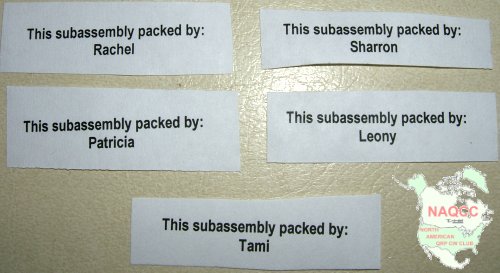 And to close, the finished product, top, bottom, and in its case: 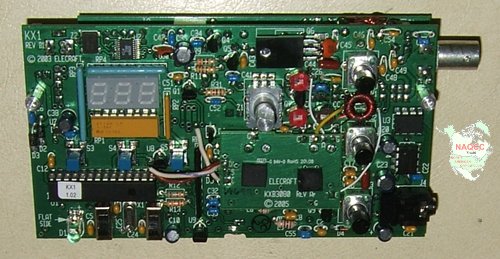  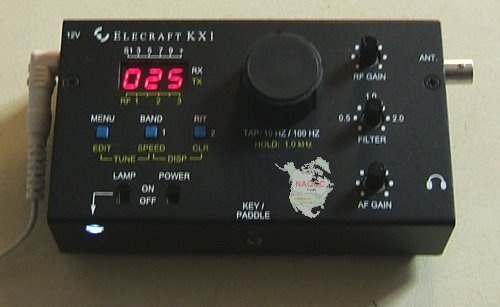 Good Day! NOTE - This series of KX-1 project articles and included pictures are the exclusive property of the NAQCC, and may not be copied in whole or in part by anyone. You may link to this entire newsletter if you wish, as long as the NAQCC is given full credit as the source of the information and pictures. 4. THE NAQCC ELMER PROJECT - FROM K5DUZ, N3IJR, AND KC8FS: - We are going to try a test run on our slow net starting in April. The net will be at 8:30 PM est on 3.680 MHZ + 5 if needed. We will be using the club call, N3AQC, and for the time being N3IJR will be the net control station. We will be QRP of course and we hope to hear from as many of our members as possible. Our goal is to have a place were you feel comfortable no matter what your skill level is with Morse Code. The net will be informal and it will be a place were we can improve our Morse Skills and just ragchew a little. So I look forward to hearing you on the net and we will see you Sunday Night, April 5th at 8:30 pm est. You will hear CQ de N3AQC followed by QNI, then just send your call and I will come back to you. I will send AS which means to stand by as I take more calls. Then we will go dwn the list and give everybody a chance to send and hear some code. See you all then and 73 N3IJR/Karl If you are interested in helping out or need help with any CW and/or QRP matters contact: K5DUZ - N3IJR - KC8FS - Also see Elmer Project on the web site. 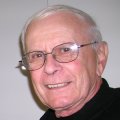 5. CW CARTOON OF THE MONTH: Let's take a comedy break now courtesy of Dick Sylvan W9CBT. Dick has been a long-time QRP/CW operator. One of his many talents is being a cartoon artist, and he is supplying a cartoon each month for the newsletter. The NAQCC is very honored to be one of just two organizations to feature Dick's cartoons. In addition to our newsletter, Dick's cartoons appear monthly in The K9YA Telegraph, an on-line only Ham Radio E-zine where he is the staff cartoonist. Dick has also authored a book entitled "Hi Hi - A Collection of Ham Radio Cartoons" available via his web site. A new cartoon will be appearing in each of our even-numbered newsletters. 5. CW CARTOON OF THE MONTH: Let's take a comedy break now courtesy of Dick Sylvan W9CBT. Dick has been a long-time QRP/CW operator. One of his many talents is being a cartoon artist, and he is supplying a cartoon each month for the newsletter. The NAQCC is very honored to be one of just two organizations to feature Dick's cartoons. In addition to our newsletter, Dick's cartoons appear monthly in The K9YA Telegraph, an on-line only Ham Radio E-zine where he is the staff cartoonist. Dick has also authored a book entitled "Hi Hi - A Collection of Ham Radio Cartoons" available via his web site. A new cartoon will be appearing in each of our even-numbered newsletters.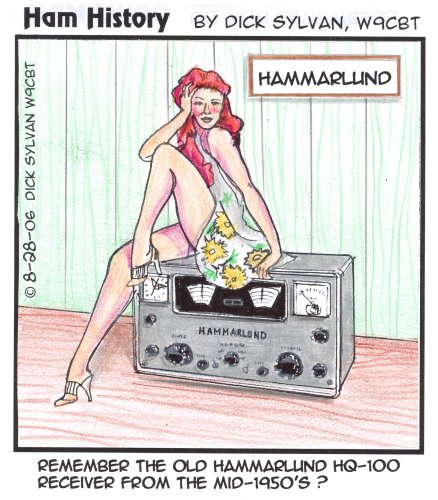 5. NEWS ITEMS AND ARTICLES BY OUR MEMBERS: This section is a forum for you to tell other members what you've been up to on the ham bands or to submit an article dealing with some aspect of CW and QRP operation or equipment. Send your news items and articles to our news editor Paul KD2MX at (disclaimer) Any views expressed here are those of the member submitting them, and may not be in agreement with those of the NAQCC. At my sister-in-law's house I set up the rig on an end table in the living room. I ran the antenna wire up the nearby stairwell to the second floor and across the ceiling of the upstairs hallway to a curtain rod in the bathroom at the end of the hallway. The antenna was held in place with a couple of pieces of masking tape. The counterpoise was just laid out across the living room floor. I couldn't hear anything on 20 or 30 meters but 40 sounded OK. The ATU claimed about 1.6 watts out with an SWR of 1.1:1, but I'm not too sure that I trust those readings. I really didn't think that this would work but as I tuned around I heard K1MBF with a good 599 signal just finishing up a QSO. I waited until he was done and then gave him a call. I was really surprised when he came back to me! He gave me a 559 in TN and we had a very enjoyable chat. I didn't have time to make another contact. The bottom line....If it can't possibly work, give it a try anyway! |
| The publication of our next newsletter will be announced via email to all members for whom we have a valid email address unless they specifically have unsubscribed from the email. Unless otherwise credited, all items are written by K3WWP. If you came directly to this newsletter, we invite you now to browse the NAQCC Web Site. |